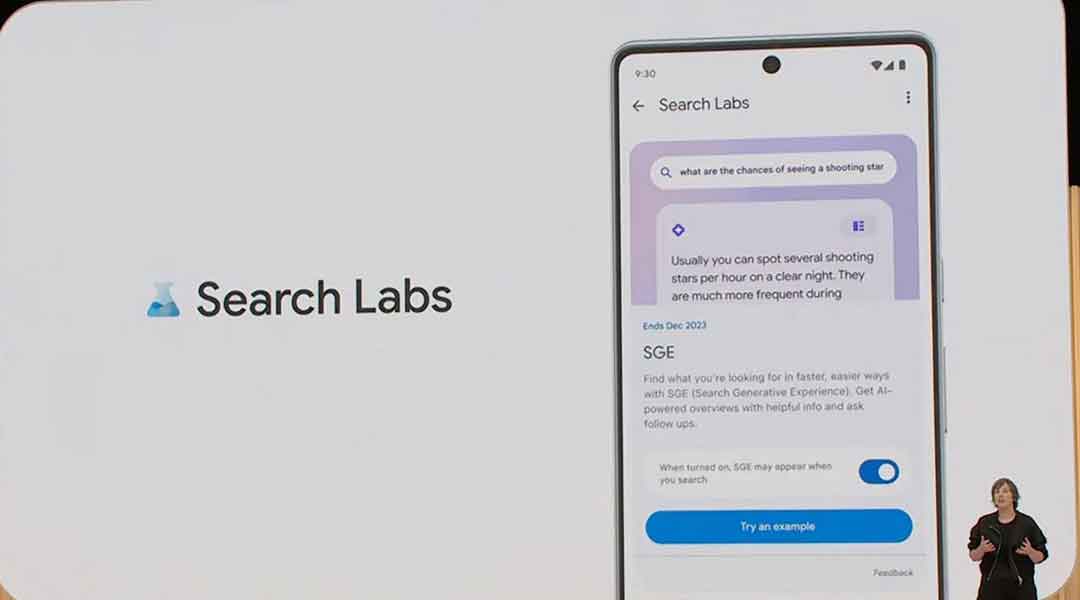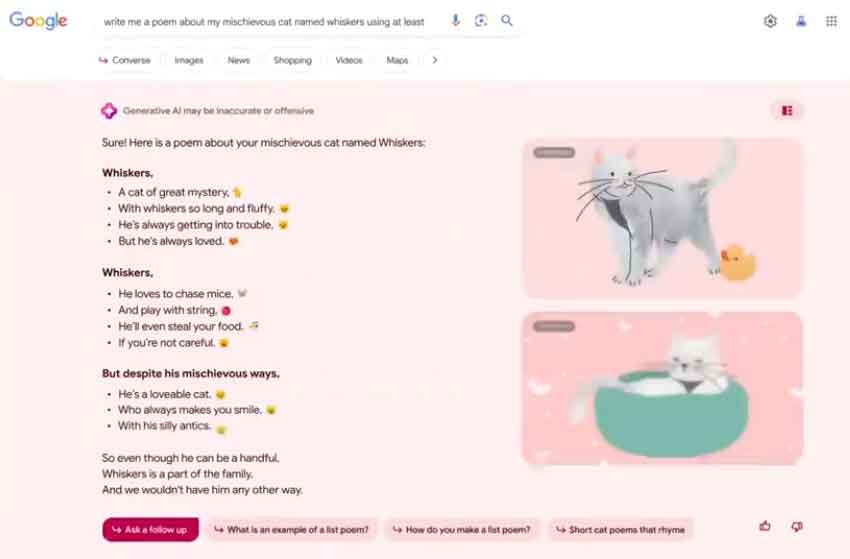Google SGE, also known as Search Generative Experience, is a recent development that adds generative AI capabilities to Google search results and offers users an improved way to conduct searches online.
It emphasizes creating new and personalized content by combining generative AI with original results and the latest information from various sources. As this technology continues to evolve, it has begun impacting the types of SERP features available for consumers engaging in web queries via Google’s platform, meaning more comprehensive answers are returned faster. Not only does this mean more effective searching options, but better user experience, too, given its ability to effectively emulate conversation-like interactions between people and machines.
Allowing such cutting-edge innovation speaks volumes about where SEO stands today and holds potential implications for businesses worldwide looking to optimize their presence through digital media channels using powerful algorithms like those provided by SGE concepts.
Introduction to Search Generative Experiences
Google’s Search Generative Experience revolutionizes how users interact with search engines by providing AI-generated answers directly above traditional search results listings. As an experimental feature, SGE aims to deliver more accurate and useful information tailored to each user’s query while saving time browsing numerous websites. When you enter a query into Google, the system presents an AI-powered snapshot of key facts related to your question alongside relevant links for further research.
One primary aspect that sets SGE apart from regular searches is its dynamic interface, designed to reflect various journey types and specific intentions behind queries. This functionality extends beyond general searches; it offers personalized vertical experiences like those in Google Shopping results. With 35 billion product listings on their platform updated hourly, enabling real-time responses is crucial for maximum efficiency and accuracy.

Source: Google
Users also have access to follow-up mechanisms when using this novel feature: they can easily refine or add details about initial inquiries via “Ask a Follow Up” boxes provided within answer panels themselves! To enhance understanding between questions asked sequentially, whether seeking additional clarification after receiving an inputted response or exploring alternative perspectives available online, context plays a significant role throughout the interaction process. Powered by artificial intelligence systems that recognize relevance from previous engagements, these systems determine the optimal way to address evolving informational needs during conversations over time.
As part of these innovations come new ways people engage with the internet, such as searching abilities embedded in language models, including MUM PaLM2. Emerging tools are being utilized to create such a unique experience, as they’re purposefully trained to carry out tasks exclusive to identifying high-quality web sources to corroborate presented output. This streamlines website exploration and enables focused, deeper dives into topics of interest, making the whole undertaking, which is often complex and otherwise difficult, feel much more organic and natural.
Ultimately, this allows for greater ease of discovery and knowledge without the overwhelming intensity traditionally associated with extensive sifting and rigorous data filtering.
Exploring SGE on Desktop and Mobile Devices
SGE on mobile devices is a great way to stay ahead of the curve. The AI-based technology offers a similar experience to that of desktops, with quick responses appearing as snapshots adjacent to relevant links in response to complex questions. These links offer additional information that could be beneficial according to user preferences or particular concerns about businesses seeking growth opportunities online.
Moreover, if the concise snapshot doesn’t cater entirely toward answering your query, clicking on the “bear claw” icon expands it further, providing detailed content extracted from supporting web sources right there within seconds! This enhanced accessibility of vital data reinforces Google’s commitment to driving traffic back onto websites while upholding its primary goal: helping people access better answers faster.
Comparing SGE Results to Standard Google SERP Features
One notable distinction between the two is how efficiently complex questions are addressed. Standard search results may require sifting through multiple websites or articles before piecing together a comprehensive answer.
On the other hand, SGE streamlines this process by intelligently generating responses using information from several sources simultaneously. Another key difference is user engagement with online content when utilizing these advanced features compared to traditional SERPs.

Source: Google
Users only interact briefly with links related to their queries when using conventional search engine result pages. They often do not explore different aspects of the topics they are researching unless the website provides suggestions throughout their experience that encourage them to do so.
However, snapshots encourage people to explore more deeply. They provide helpful answers in a system structure and layout, which makes learning new things easy. People remain focused on the originally intended subject matter while guided through an ever-evolving network connecting webpages from multiple themes/categories. This increases overall engagement thanks to actively adaptive AI technology embedded into each query-result interaction point. It is both organic and paid, depending on preferences specified before every single session start-up event globally.
The Google Search Generative Experience offers a more immersive search experience by combining natural language understanding and AI technologies. It provides more relevant, accurate, and tailored content to users faster. This new tool lets users quickly find useful information without relying on keywords or phrases alone.
Source: Google
SGE’s Impact on Organic Search Results
As Google continues to evolve, integrating AI-powered features will reshape SERP rankings and strategies for digital marketers. With generative answers appearing in boxed formats above traditional page listings, websites may experience reduced visibility as users find their desired information without additional clicks.
To stay competitive in this changing landscape, businesses must adapt by embracing data-driven SEO practices that focus on providing relevant content and rich media elements that appeal to both users and algorithms alike. Content creators should strive to balance user engagement with captivating visuals while ensuring key information is accessible through natural language processing techniques favored by modern AI technologies. Moreover, mobile optimization remains crucial as increasing numbers of people access search engines via smartphones or tablets rather than desktop devices.
Prioritizing responsive web design ensures your site maintains its functionality across various screen sizes, which is essential when targeting diverse audiences who value seamless browsing experiences online.
Ultimately, staying informed about emerging trends within the realm of Search Generative Experiences is important. It empowers you to make strategic decisions based on up-to-date developments regarding industry best practices. This approach is necessary to maintain positive organic ranking outcomes in an ever-evolving online ecosystem driven by innovative technologies like SGEs.
Google SGE: Improving SERP Features
In this ever-changing environment, digital marketers and content creators must stay informed about new developments that could impact their SEO strategies. One essential aspect is understanding how SGE influences SERP feature performance and identifying which features are most likely driving organic traffic.
The Search Generative Experience has significantly impacted the landscape of SERP features. SGE leverages the power of generative AI to enhance the search experience and provide users with more relevant and informative results. One of the key impacts of SGE on SERP features is the improved diversity and richness of search results. Generative models can understand the context of a query better and generate more nuanced and comprehensive responses. This leads to a wider range of search results that cover different facets of a topic, giving users a more holistic understanding of their queries.

Source: Google
Another notable impact is the increased personalization of SERP features. By analyzing a user’s search history, preferences, and behavior, SGE can tailor the search results to match individual needs and interests. This personalization enhances the user experience by delivering more relevant results aligned with their specific requirements.
SGE has also contributed to developing interactive and visually appealing SERP features. With generative models, Google can generate dynamic elements, such as carousels, sliders, and interactive widgets, that enhance the presentation of information on the SERP. These features enable users to interact directly with the search results, providing a more engaging and immersive search experience.
Additionally, SGE has improved the accuracy and quality of rich snippets and featured snippets on the SERP. Generative models can analyze content from various sources and generate concise summaries or key highlights displayed as featured snippets. This helps users quickly grasp the most important information without clicking through multiple search results.
Here are some key areas where SGE has influenced Google’s SERP features:
FAQ, People Also Ask, and Knowledge Panel SERPs: These features now provide more comprehensive and relevant information, making it easier for users to find answers to their queries. The Knowledge Panel has also become more informative, offering detailed insights and structured data about entities and topics.
Local Pack Search Results: Users can now find more accurate and up-to-date details about local businesses, including their reviews, ratings, contact information, and opening hours. This helps users make informed decisions when searching for local services or products.
Shopping and Reviews Search Results: Users can now view a wide range of products, compare prices, read reviews, and access relevant information directly on the SERP. This saves users time and provides a more streamlined shopping experience.
Source: Google
Product Details and Store Listings SERPs: Users can now see more comprehensive product information, including specifications, images, and prices. Store listings also provide users with essential details such as addresses, ratings, and reviews, making finding and evaluating products and services easier.
Sponsored Ads and Featured Snippets: Sponsored ads are now better targeted, ensuring users see advertisements that align with their search queries. Featured snippets offer concise and informative summaries directly on the SERP, providing quick answers to user queries.
News and Top Stories SERPs: Users can now access a broader range of news articles, view related stories, and access reliable sources for up-to-date information. The SERP also includes a carousel of news articles, allowing users to explore different perspectives.
Image Search Results: Users can now find more visually similar images, explore different image formats, and access additional information related to the images directly on the SERP.
Video Search Results: Users can now preview videos directly on the SERP, access video descriptions and ratings, and even watch videos within the SERP itself in some cases.
Event Search Results: Users can find event dates, locations, and availability and purchase tickets directly from the SERP.
With GSGE, Google continues to push the boundaries of search technology, making it easier for users to find the information they need quickly and efficiently.
Improving the Relevance and Quality of SERPs
Improving the relevance and quality of search engine results pages (SERPs) is a core aspect of evolving search generative experiences. By embracing modern AI technologies like MUM, Google continues refining its understanding of complex queries and user intent, leading to more accurate search results tailored to each individual’s needs. Moreover, advancements in natural language processing enable SERP features such as rich snippets or knowledge panels that provide valuable context quickly with minimal user effort.
Source: Google
These refined display formats enhance the overall searching experience by highlighting pertinent information on the SERP itself. As machine learning algorithms analyze extensive datasets relating to browsing behavior patterns across diverse demographics, they ultimately contribute towards crafting personalized searches based on factors like location or past interactions. Consequently, these sophisticated techniques feed into higher conversion rates and increased user satisfaction.
The Search Generative Experience has profoundly impacted Google’s SERP features, making search results more comprehensive, informative, and interactive. Users can now access more relevant information directly on the SERP, saving time and improving the overall search experience.











